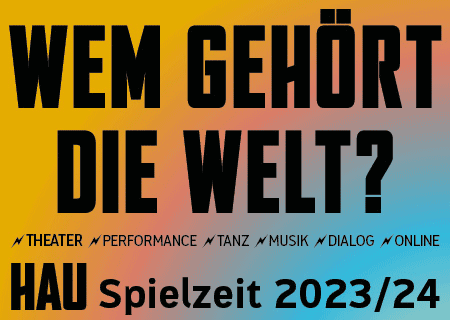Raphaele Shirley: “Anyone’s own belief system drives the framework of their existence”

Raphaele Shirley (Photo: David Heald)
Raphaele Shirley is a French/American multi-media artist whose work spans installation art, light sculpture, video, art collectives and social intervention. She deals with questions of space, time, primordial life forces, and the ephemeral.
I met Raphaele around 2010 in NYC through Algis Kizys one of the bass players of The Swans. We met quite often for tea or drinks with befriended musicians and I discovered that she is a prolific artist that creates beautiful objects and installations. After having worked with Nam June Paik (1997–2002) she began sculpting in pure light. Her installations radiate an unusual calm and mesmerizing serenity that have transfixed me from the first moment I saw them and I am delighted to have this opportunity to present her exceptional creations and speak in depth with Raphaele about the ideas behind her light.
Your work deals a lot with light and space. When I look at it I feel I am looking at the universe. It always radiates a sort of calm, which is impressive. What is it that you are looking for to express and in art in general? Is there a general theme or does it differ from object to object?
I usually work on a single theme per decade. The last decade has actually been dedicated to the quandary of how to represent “The Universe“. It started when I stumbled upon a reproduction in the New York Times of the painting “The Creation of the World and the Expulsion from Paradise” by Giovanni di Paolo (1445). I was stunned by the composition and the contemporaneity of the painting, in particular the color wheel representing the universe from a Ptolemaic point of view, with the earth at the center of the world. The “world” from a medieval perspective was considered static and only God, pictured in the painting setting the world in motion, could generate change and movement. I focused on the color disk in the painting and saw in my mind’s eye the same color wheel as a massively large, super-fast light disk, something in the dimension of a speed-skating rink made of light, in the form of streaming colors spinning.
In 2010 my father passed away and a lot of my work was black and white at the time. I needed to blow light and color towards the void of death and to chase my sorrow, so I set out to create the vision I had had upon stumbling on this image.
My first interpretation was “Light Shot on a Bender” (2010) where I recreated the Giovanni color wheel in LED strips arranged in a circle on a 2 meter wood surface. This was shown in a very long unpaved alley-way, with a city view behind the art work, for the “Bring to Light” festival in New York. I shrouded the disk in water mist to create the dynamism of the “hand of god”. To my amazement the relatively small object, related to the street it was placed in, managed to command the alley the length of a block and drew in the streaming crowds towards it like a beacon, and this in the rain!

/e-mediac\ (Photo credit: Michael Lisnet)
I moved on to another Piece called “Black star” (2014), in which the “world” disk was simplified to a single outer circular line of light of 4 meter diameter and an inner flat black circle painted directly on the wall. Here the combined disk, through the dynamics of internal relationships of light and dark, started touching on themes of totality found in Buddhists philosophy as well as referring to cosmological phenomena like eclipses and black holes. The work, although super flat, surprisingly gives the impression of a very voluminous three-dimensional object.
I continued the journey of the reinterpretation of the Giovanni disk in several more bas-relief, wall hung light pieces, while doing parallel research on other forms of representation of the Universe, like those found in some of Steven Hawkins books and science illustrations from online image searches, as well as collecting different representations from belief systems from around the world.
It is a life-long quest to discover a satisfying way to represent the Universe, and I’m, of course, not attached to a concept of the earth at the center. But I was curious to see how the abstraction of that simple representation led me to many other belief systems, eastern and western and then, directly to hard science/cosmology.
But after this last decade delving into this topic I’m finally ready for a new theme. Lately I’ve headed towards more ephemeral work made of clouds (“100 pink smoke flares”) or immersive installations and live performances creating temporary light sculptures with accompanied live sound (“12.6 Lyrae, /e-media-c\”).

12.6 Lyrae at The Chimney NYC photo credit: Jennifer Houdrouge
There is a spiritual feeling to your objects. Are you interested in spirituality? Do you think that art and spirituality are one?
There’s a great quote by Albert Einstein “The most beautiful thing we can experience is the mysterious. It is the source of all true art and science” or “In scientific thinking there are always elements of poetry. Science and music require a thought homogeneous”. Also, the beautiful statement by Bruce Nauman in his work “The True Artist Helps the World by Revealing Mystic Truths” comes to mind here. One can find the full dimensions of existence better through poetry and by extension art, as these forms transcend Cartesian thinking. Poets such as Rumi or Walt Whitman articulate the complexity of time, life and death, through a great economy of words. Not only does art have the possibility of describing existence better but it offers the freedom to explore multiplicity and infinite possibilities unbound by empiricism.
I had a conversation over dinner with the artist Steina Vasulka, where, we came upon the topic of death. She mentioned an Icelandic belief whereby – “death is what you believe it to be”. Taken literally, this points towards quantum theory. One can ask oneself: What if? What if the person who believes in reincarnation reincarnates? What if the one who dreams of heaven and hell goes to heaven (or hell)? The one who believes they disseminate as particles of energy, does etc. Framed by the conceptual reference, anyone’s own belief system drives the framework of their existence.
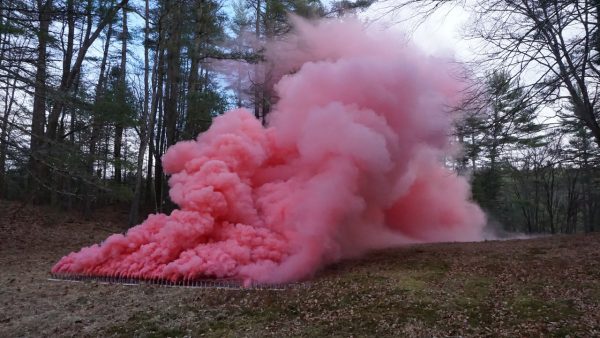 I understand more this way of thinking through the raising of my daughter who is now 3 and our time together in the realm of make-believe. Her lens on the world is mainly symbolic; she sees things in synthesis and shortcuts, shrouded in magic and with animals at the center. Everything is metaphor, imaginations are part real. She and I mix and match characters, create beings that are hybrids, give ourselves fanciful titles, identify as multifaceted morphing creatures. It’s fun! The variations seem infinite. For an adult, this playtime helps to open the mind to accept a broader frame of reference.
I understand more this way of thinking through the raising of my daughter who is now 3 and our time together in the realm of make-believe. Her lens on the world is mainly symbolic; she sees things in synthesis and shortcuts, shrouded in magic and with animals at the center. Everything is metaphor, imaginations are part real. She and I mix and match characters, create beings that are hybrids, give ourselves fanciful titles, identify as multifaceted morphing creatures. It’s fun! The variations seem infinite. For an adult, this playtime helps to open the mind to accept a broader frame of reference.
The dream world and subconscious seem to function with the same logic as a child’s mind, unbridled forms of perception and powerful indicators towards a larger view of reality constructed on free-association. In dreams animalistic gods or concepts of eternal return, reincarnation or infinity of time are all feasible. Religions share the same source and conceptual space as dreams. They are metaphorical portals of wisdom; their symbology is stripped of the original intent when taken too literally. Right now utilitarianism and the post-industrial society has humanity’s mind in a vis-grip, annulling expansive thought and leading us astray, far from a more colorful, creative and free perception of things.
I can credit influences of early childhood for orienting my thinking. My father, Hunter B. Shirley, was a theoretician in psychology and spoke at length of the subconscious. My grandmother, his mother, was a devout southern Baptist (of the good and kind type). She imbued me with a sense of awe and the sacred. My mother, from the French Couelle family, who are mostly architects, and namely Jacques Couelle, gave me the sense of the power of art. In my early teens, I read a lot Lao Tzu and Lie-Tseu who speak of “The Void” in very clear, palpable ways, kindred to contemporary cosmological descriptions of black holes, dark matter and the ways of the universe in general etc. (with a lot less words!). These readings presented to me an idea of a total view of things, including the notion of Nothingness and Entropy at the heart of all existence.
So right now, I see a correlation between advanced science, religions from around the world, the subconscious, dreams and the child’s mind. If I can make a synthesis of these different points of view and express this somehow through the magic of art, where a palpable notion of mystery and unity in multiplicity is communicated to the viewer, I feel I will have succeeded. I hope my pieces can carry multiple truths, crossing over through belief systems to unite diverse meanings. Finally, if I can portray a notion of totality or oneness inspite of the great force of opposites, I consider my pieces a success!
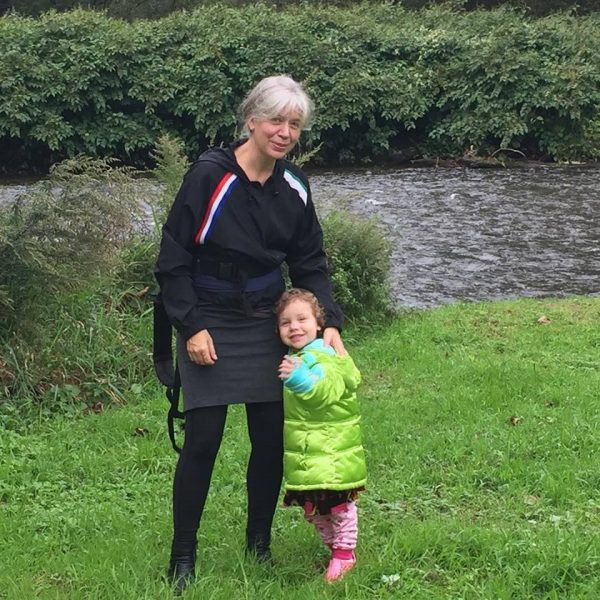
Raphaele Shirley and her daughter (Photo: Stephen Zachs)
Your objects always magnify the space around them, which I find fascinating. Is this something you create knowingly or is it an accidental side effect?
I was taught in my 20’s, working with a group of French stone sculptors, what they called the “first principle” of sculpture that came down, they said, from the ancient Egyptians and beyond. The principle was that of finding the center of the stone and then always working in dynamic relation with it, so that there is always a form of tension on the surface that pushes from center outwards into space.
Although I am not working with stone anymore I think I am still applying this principle in multi-media. Whenever I make a piece, I consider the space, the audience viewing the work and its physical context as part of the work. All of these elements are materials of the artwork, equal to say paint, clay or metal and they need to interact with the center of the artwork.
Thinking of the relationship of harmonics of sound to space, I strive to create, in my pieces, a state of resonance similar to that which is found in music, where surrounding space resonates in harmony with the object I’m making and vice versa. When this really works one can produce a somewhat small object or painting which then through its relation to the space around it, jumps in scale to the infinite. That’s exciting!
In the best of circumstances, I think that an artwork is successful if it can function or resonate almost in any space with basic settings suitable for it (sufficient wall size, minimum distance viewing etc.). Multi-media artworks often separate parts that can be disassembled; the integrity of the work, if disassembled, can decay and loose connectivity to space. I’m interested in that moment of weakness as well. What are the limits of adaptability of an artwork, how much care does it require to keep it alive? When does it die?
Where do you find the calm and peace your objects radiate in NYC?!
I really miss nature in New York so art becomes the channel by which I can find some form of peace or what one would call a meditational space. I make a lot of work in response to the busyness and the frenetic-ness of the city, as a calming force, helping to find calm within myself, a challenge when there’s lots of stimulation or too much financial pressure.
Also I try to make my pieces “resolve“ external space. In other words, sometimes our environments can be very eclectic with diverse objects or incoherent spatial construction, with multiple meanings or purposes. Sometimes too many options or open- endedness exist in a room —a successful art object would settle these into a clear flow, tie opposites, resolve irreconcilable concepts or directions. It’s a tall expectation for a piece but I’ve seen the results in action, maybe simply by having this as part of the artistic intension, the effect occurs?
In the attempt to resolve eclectic external contraries, I am able to resolve internal conflicts within myself. Somehow the work has to command attention and be more powerful than the “noise “, internal or external. Since there is always a lot of such “noise”, the artworks push really hard in the other direction, creating a voice that ends up being distinguishable in a sea of voices or cacophony. I wonder what work I might make if I lived in an ultra-calm and coherent place, like a desert or a forest? I’ll have to try and see what happens!
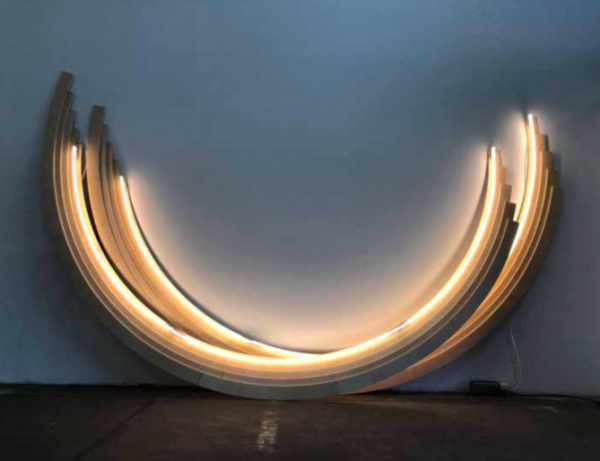
How does the current state of affairs (political, environmental, social) influence your art /life?
The Orwellian nature of news these days has reached a whole new level, provoking sensations of nausea, making one’s blood boil or attacks of crying. We are lucky to come off with a “business as usual” response. The disaster of our US presidency with its tragedy of the Mexican border, US prisons in general, the great scam that is our US medical system, the relentless destruction of the middle eastern countries and, in broader terms, the churning of humanity that is breaking the earth… all these things generate great fear or make the blood boil. Hollywood is partially responsible for the state of things with its obsession with dystopian and Manicheanrepresentations of the world. It has the power to be a guide and illustrate paths and instead obscures them into simplified cartoon realities, which mislead.
Positive aspects of today’s news become beacons and pillars of optimism on which to hold onto. Whether it be the great politicians coming out to tackle our grotesque presidency, or new inventions towards sustainability and cleaning the oceans, or amazing science discoveries. Through all this, another dimension of optimism remains: the importance of art and artists as shepherds of meaning.
Some friends of mine, Louis Putzel and Tony Tate, who worked directly for conflict resolution in Burundi, mentioned regarding the war in neighboring Rwanda, between the Tutsi’s and Hutus, the story of instances of peace where the ongoing vicious slaughter would cease for the advent of a concert and all would come together to dance. This says so much I think. Once we abandon our connection to art, we leave the door open to abasement and unraveling’s of humanity gone unchecked. So, today’s news pushes me deeper towards art as a response and a source of existential direction.
I spend more time, in museums, particularly the Metropolitan Museum of Art, in sections such as the Arts of Africa, Oceana and Americas, as I know less of these cultures than classical European art, and I am currently interested in more raw, tribal type responses to life, which can be found in the former. This is not escapism but an attempt to find a new direction via the guidance of history. All these world treasures were made in times of political turmoil, sometimes under the rule of unjust rulers, wars, torture, diseases, suffering. The power of the art objects survived the losses of times they were produced in. What is the message they carry forward in time?
Regarding the direction of my practice, I have taken a break on some of my artworks for ecological concerns. Several of my pieces involve water or large amounts of electricity, and some incidental form of resource consumption that I’d like to avoid. 2012 was, what I call, my “monumental” year, where I mainly worked on paper, sketching building- scale/park-scale art works. But I wanted them all to rely on rain water collection, solar power, renewable energies which requires engineering on that scale. I have since worked with several architects and engineers to advance the concepts. I’m now waiting on sustainable technology to evolve and become more commonplace and accessible for ease of realization.
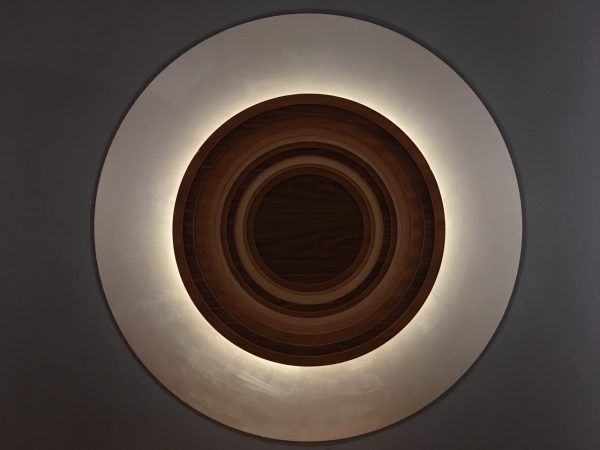
Did you study art?
Early on my parents immersed my brother and sister and I in a variety of art forms from literature, classical music, theater, sculpting, painting etc. Living in France from 1981 on, at age 14, I received a dark room kit and spent most of the following four years processing B&W photos. Consecutively I studied landscape painting and figure drawing in elective private courses. During that period, I befriended a group of stone sculptors students of Rene Coutelle, himself apprentice of Gustave Rodin. Together we studied sculpture and art history spanning from ancient Egyptians to early 20th century, through practice, books and a lot of time spent in diverse museums in Europe. We had a particular focus on medieval painting but also French literature (Rimbaud, Baudelaire, Le Comte de Lautreamont etc.). Finally, I went to the Beaux Arts d ’Aix-en-Provence but got called, in 1993, to go to New York to work on art projects, which seemed too exciting to refuse. I ended up in the Fluxus building, 537 Broadway living on the 4th floor, two floors above the current Emily Harvey Foundation. There I worked with artist Elaine Summers and sculptor Francis Whitney who lived in the building, and later became a studio assistant to Nam June Paik from 1997-2002. I was painting at the time, which is quite solitary, so to keep my artist’s hand fresh and to meet people, I worked with directors Karin Coonrod, Aaron Beall and Randolph Curtis Rand designing sets, costumes, props and video designs for their shows. So, excepting the one year at the Beaux Arts d’Aix, one could say it was a long “on the field” education!
What are you working on momentarily?
My piece “100 pink smoke flares (twice)” will be shown in the port of Tallinn, Estonia for the opening ceremony of a new contemporary art center, the Kai Art Center, on September 20. It will be introduced by a group of Estonian experimental musicians lead by Katariin Raska. This site-specific piece was initiated in 2015 with Stephen Zachs and a project called “Chance Ecologies”. It has been shown in several different locations including the Queens Museum in New York and in Flint, Michigan in the former industrial site of the Chevy Factories.
Next year, in June 2020, I will have a survey exhibition; in a growing art space called the Sprinkler Factory, in Worcester, Massachusetts. The space is an expansive and raw which is always exciting for my work, as it seems to thrive in that environment almost better than in traditional white wall galleries. I’m also furthering some of my collaborative and performative pieces such as “12.6 Lyrae/Le Chiffre” with composition by Algis Kizys with participation of musicians Laura Ortman, Vinnie Signorelli, Lynn Wright and David Watson. This piece was first shown at the space, the Chimney, in New York. My piece /e-media-c\ presented with David Watson, Peter Zummo and Kevin Shea at Hunter’s College New York will certainly be presented again soon. As well “3by3by3″, a collaborative interactive sound and light work developed with GH Hovagimyan and Rhys Chatham, will hopefully be presented again in 2020. Recently I got excited by the large fountain in Queens museum in New York. With the choreographer Rachel Cohen from Racoco Productions, we’re preparing a light and movement performance that engages the whole fountain.

Photo: Michael Lisnet
What are your plans for the future?
Raphaele: I often let an idea sit for a couple of years to make sure it is worthwhile. I have a lot of concept drawings and unrealized proposals developed over the last decade, which are calling me to complete them. I have a body of modular artworks, sculptures and paintings, developed since 2007, which I would like to show. They are pieces that can be presented in multiple arrangements, which I hope to solidify as an artistic statement in an exhibition. Also, after so much time spent in my youth looking at pre-renaissance painting, the landscapes and backgrounds in them have stayed with me as stand-alone environments. The heavenly spaces painted by Masaccio, Mantegna, Piero della Francesca, Fra Angelico or Giotto have morphed, in my mind, into ephemeral abstract sculptures. The piece “Shooting Stair” (2009) created for Fred Dorfman’s garden stems directly from this vision. I have a few more to realize, akin to angels in the form of light plunging into a backyard, a celestial disk hovering over a dining room table…I’m interested in bringing an element of magic into the everyday, creating artwork-portal of sorts.
I also have some sculptural interventions for gallery spaces I’d really like to undertake. They are ultra-dynamic, involving somewhat punkish actions, such as spraying large jet of water against a gallery wall combined with a flood of streaming light, or having rumbling base sounds shake a space with strobes and emptiness. Seems somewhat unreasonable, but certainly entertaining for all…
I’m also interested in more “analogue” creations, that require less wires and less extensive electrical and equipment set-ups. My piece “/e-media-c\” is composed of two 2meter large parabolic mirrors on wheels, 5 powerful flashlights and non-amplified music. It is exciting to see that the piece reaches monumental expression with an economy of means (and a small suitcase!).
Finally, I’ve had a lot of time for reflection since my daughter’s birth, which probably gave space for renewed creativity, as I’ve been having very elaborate dreams lately. In these dreams entire new bodies of works are featured. The imaginary artworks often don’t relate to anything made to date. This gives me pause and opens up a lot of possibilities!








